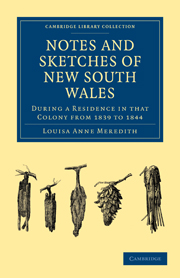Summary
I have often wondered that constant intercourse with Europeans, and experience of the comfort afforded by a permanent and substantial shelter from the inclemency of the seasons in the variable climate of New South Wales, has not induced the natives to make some rude attempt at building themselves huts, especially as they are always very glad to enjoy the benefit of dwelling in those of the settlers. But their idleness is wholly unconquerable; the uttermost effort they ever make towards the formation of a residence being to raise a few strips of bark slantingly against a tree, under which they crawl during bad weather. Had not these primitive erections been pointed out to me as “natives' huts,” I confess I should not have had an idea that they were anything more than accidental heaps of bark.
One very wet miserable day a black was crowding in the warm chimney-corner of a “squatter's” hut, where my husband was present, and some of the party were asking the native why he was so idle and stupid as to go shivering about without a home, when he might soon build himself a warm hut. He listened very quietly to all they had to say, merely observing at last, with the air of a man who has arrived at a most philosophical conclusion:—“Ay, ay! White fellow think it best that-a-way—Black fellow think it best that-a-way.”
- Type
- Chapter
- Information
- Notes and Sketches of New South WalesDuring a Residence in that Colony from 1839 to 1844, pp. 103 - 113Publisher: Cambridge University PressPrint publication year: 2010First published in: 1844

